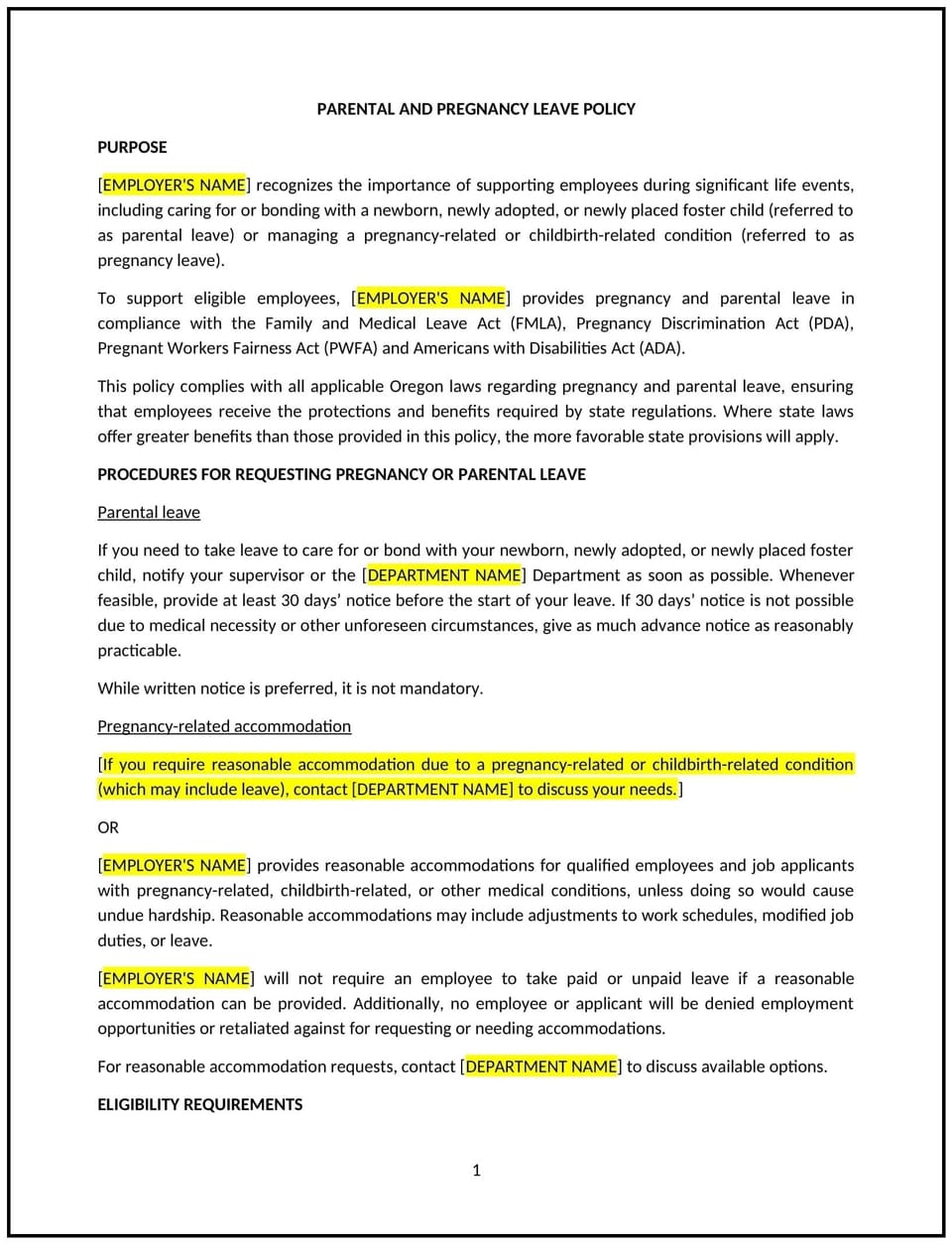Parental and pregnancy leave policy (Oregon): Free template

Parental and pregnancy leave policy (Oregon)
This parental and pregnancy leave policy is designed to help Oregon businesses support employees during pregnancy, childbirth, adoption, or foster care placement. It outlines procedures for requesting leave, job protection, and benefits during leave.
By adopting this policy, businesses can promote work-life balance, comply with state and federal laws, and enhance employee satisfaction.
How to use this parental and pregnancy leave policy (Oregon)
- Define eligibility: Clarify which employees are eligible for parental and pregnancy leave, such as new parents or expectant mothers.
- Outline request procedures: Specify steps for employees to request leave, including required documentation.
- Address pay and benefits: State whether employees will receive pay or benefits during leave and any conditions that apply.
- Ensure job protection: Confirm that employees will return to the same or an equivalent position after leave.
- Train managers: Educate supervisors on handling leave requests and maintaining workflow.
- Review and update: Assess the policy annually to ensure it aligns with evolving state and federal laws.
Benefits of using this parental and pregnancy leave policy (Oregon)
This policy offers several advantages for Oregon businesses:
- Supports employees: Demonstrates a commitment to employees during significant life events.
- Promotes compliance: Aligns with state and federal laws, such as the Family and Medical Leave Act (FMLA) and Oregon Family Leave Act (OFLA).
- Enhances satisfaction: Boosts employee morale and retention by offering paid or unpaid leave.
- Reduces legal risks: Minimizes the potential for disputes or penalties related to leave requests.
- Builds trust: Shows employees that the business values their personal and family needs.
Tips for using this parental and pregnancy leave policy (Oregon)
- Communicate clearly: Share the policy with employees and include it in the employee handbook.
- Provide training: Educate managers on handling leave requests and maintaining workflow.
- Monitor compliance: Regularly review leave requests to ensure adherence to the policy.
- Address issues promptly: Take corrective action if leave requests are mishandled or denied improperly.
- Update regularly: Revise the policy as needed to reflect changes in state or federal laws.
Q: How does this policy benefit businesses?
A: It helps businesses support employees during significant life events, comply with laws, and enhance employee satisfaction.
Q: Are employees required to provide proof of pregnancy or adoption?
A: Yes, employees should provide documentation, such as a doctor’s note or adoption paperwork, to support their leave request.
Q: Do businesses have to pay employees during parental or pregnancy leave?
A: Oregon law does not require businesses to pay employees during leave, but some businesses choose to offer paid leave.
Q: Can businesses deny parental or pregnancy leave requests?
A: No, businesses cannot deny legitimate leave requests under state and federal laws.
Q: How often should this policy be reviewed?
A: The policy should be reviewed annually or whenever there are significant changes to state or federal laws.
This article contains general legal information and does not contain legal advice. Cobrief is not a law firm or a substitute for an attorney or law firm. The law is complex and changes often. For legal advice, please ask a lawyer.


